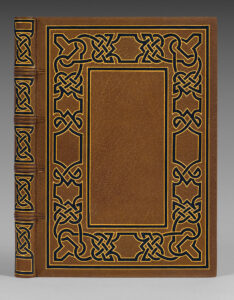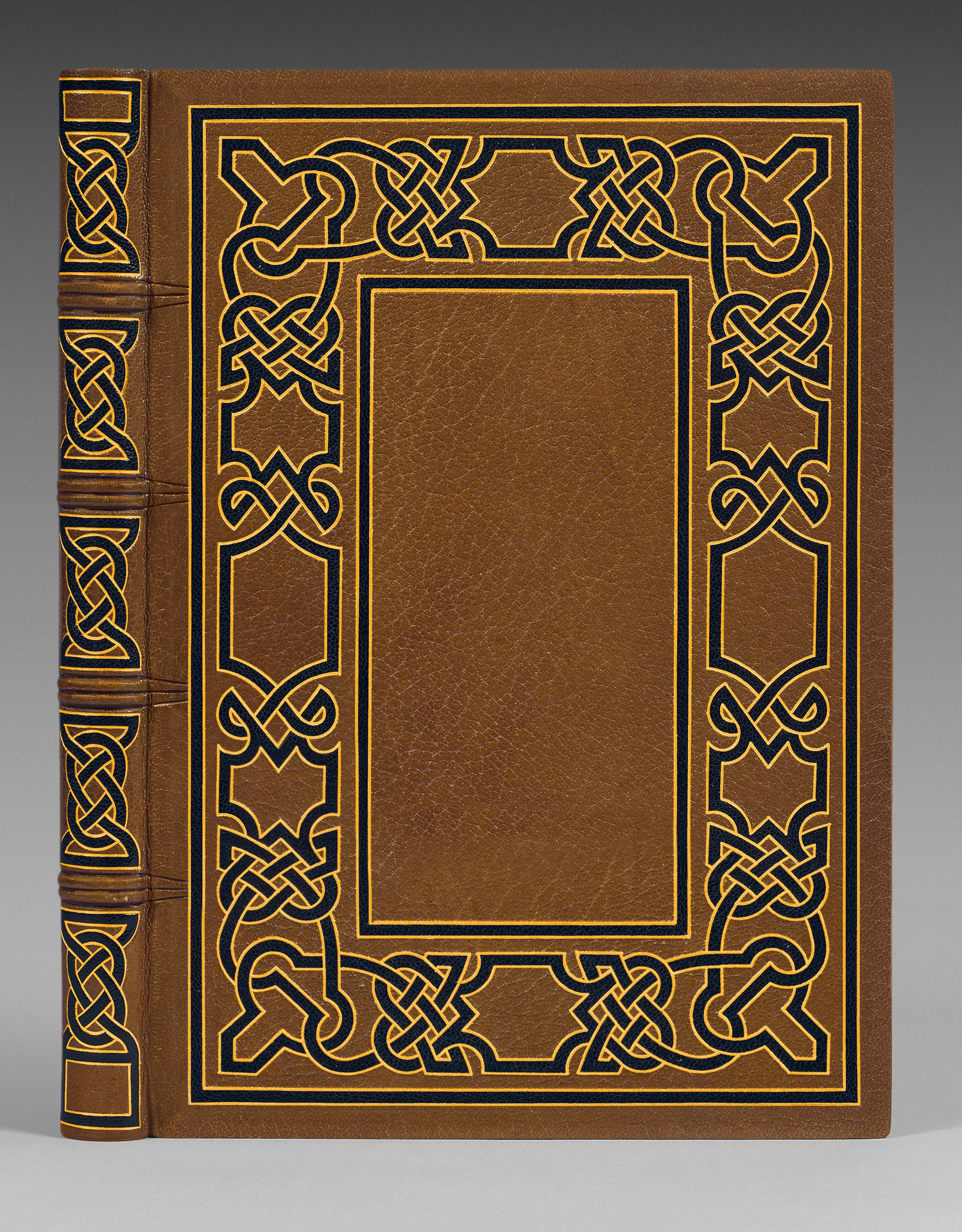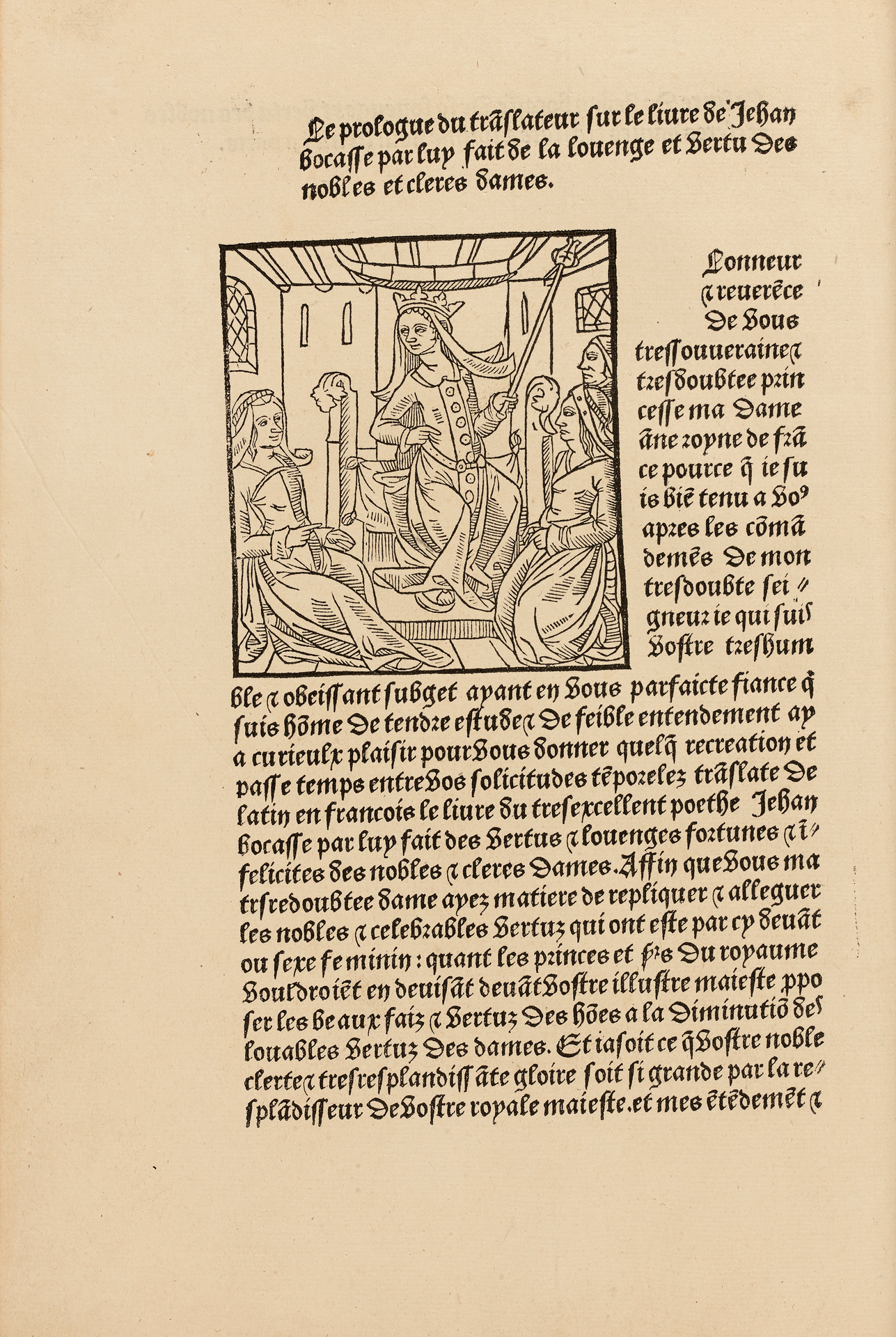A Paris, Antoine Vérard, 1493.
Folio [273 x 192 mm] of (144) ll. (a-n8, o-p6, q-r8, s-t6) of 34/35 lines.
Full light brown morocco, covers decorated with a black mosaic pattern of interlacings framed with gilt fillets, spine ribbed decorated as such, vellum-skin doublures and endpapers, gilt edges. Binding signed by Marius Michel
Exceedingly rare first French edition dedicated to Anne of Brittany and first issue of “De la louenge et vertu des nobles et clères dames” by Giovanni Boccaccio printed on the 28th of April 1493 by Antoine Vérard.
BMC VIII 79 ; B.n.F. Rés. G-365 ; Brunschwig 280 ; CIBN B-519 ; Fairfax Murray, FB 50 ; Goff B-719 ; GW (+ Accurti I) 4490 ; HC 3337 ; IGI 1769 ; Macfarlane 25 ; Pell. 2478 et 2478 A ; Hain-Copinger, n° 3337 ; Proctor n° 8425 ; Brunet, I, 990.
This copy is the only one complete to appear on the international market since 30 years.
The first Latin edition was published in 1473 under the title De Claris mulieribus (some famous women), in Ulm.
”The work, written between 1360 and 1362, amplified and modified in the following years, contain the biography of 104 renowned ladies of all times, from Eve to the Queen Joanna of Naples; it is dedicated to the very beautiful Andrée Acciaiuoli, sister of the Grand Seneschal Nicolas Acciaiuoli, second wife of an Altavilla Count.
The model of Petrarch and of his treaty of Notorious Men greatly influenced Boccaccio, as he admitted himself. The narrative vein is expanding there with a certain, freedom, like in the pages dedicated to the life of the Popess Joan, to the voluptuous lengths on the loves of Thisbe, to the history of the naïve Paulina, Roman woman loved by God Anubis, recalling quite closely the tale of Lisette and Angel Gabriel from the Decameron. (…) As a whole, the volume is a compromise between the historical scholarship and the tale, a pleasing erudition book, aimed not only at men but also women, – whom, declares Boccaccio, as an excuse, being used to hear stories have a greater need of it and enjoy themselves with a copious story.” T.F. G. Rouville.
The volume is illustrated with 11 woodcuts that, since repeated, form an iconographical cycle of 80 engravings.
Most of them measure 87 x 80 mm and represent a queen with a child in her arms (23 times), a queen standing with some ladies in front of her (22 times), a woman breastfeeding twins in front of a landscape (17 times). Two other engravings come from the Chevalier délibéré, printed in 1488. Two engravings of different sizes, 140 x 86 mm, show a bishop at his writing case topped with a sage and a woman; they come from the “Ars moriendi” printed by Le Rouge for Vérard, in 1492. Nine of these engravings were specially executed for this book and are therefore here in first issue.
“Extremely rare volume, illustrated with a certain number of beautiful woodcuts which are among the most interesting ones from the works published by Vérard”. (Rahir n°263).
Copy including the signs of the first issue:
– The title is printed with the mistake « nouellemet », corrected in the copy of the Pierpont Morgan Library. The Gesamt Katalog, Pellechet Polain 2478 and Hain mention « nouuellemet » with two U.
– Leave i4 is signed hIIII.
First great Italian prose-writer, Giovanni Boccaccio (1313-1375) was very famous in France, more than Dante and Petrarch, and this since the beginning of printing. He wrote as much for the people, who enjoyed the entertaining reading of the Decameron, as for the aristocracy who, in the De casibus virorum illustrium (translated into French Le cas des nobles malheureux), found a kind of ethical encyclopedia of the great men from the Antiquity.
This first edition was printed by Antoine Vérard who dedicated the work to Anne of Brittany, wife of King Charles VIII. It was for the most part due to writers engaged by Anne of Brittany, or attracted by the possibility of her patronage, as Antoine Vérard could be, that literature to the praise and defense of women was promoted in the French court.
The title only contains two lines of text. On the back of the title begins the translator’s preface, suppressed in some copies and supplemented with a miniature. In this copy it is coming with a woodcut showing the Queen Anne of Brittany seated in a throne surrounded by female characters from her suite.
On the front of the last leaf, the typographical mark of Antoine Vérard.
This translation of De Casibus virorum illustrium by Boccaccio was made for Jean de Chanteprime between 1400 and 1409 by Laurent de Premierfait. The latter belongs to a generation of French humanists under the reign of Charles VI re-discovering and celebrating classical literature since Cicero until Petrarch and Boccaccio. He was a scholar Latinist, much appreciated by the humanists of his time, but what mostly made his glory, were the translations into French from Latin (or Latin texts versions of originally Greek or Italian texts), made for aristocrat sponsors.
Bechtel mentions a cut in the word “nou|vellement” on the title, uncut in our copy and therefore labelled as: “novellement”.
Précious copy.
In half a century only one other complete copy appeared on the public market, sold for 35 000 €, 30 years ago. (Réf : Hôtel Georges V, 16 septembre 1988, n° 23, ex. S. Brunschwig).



